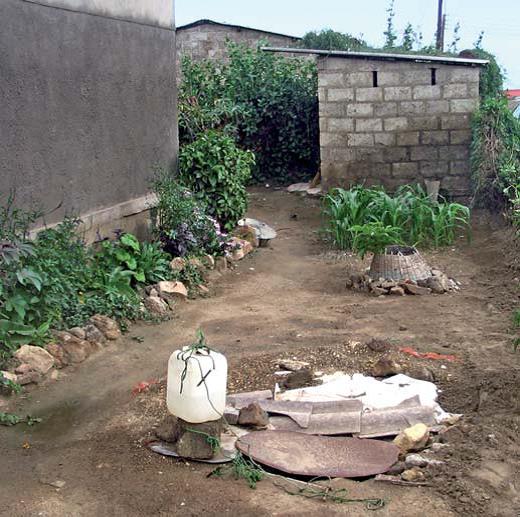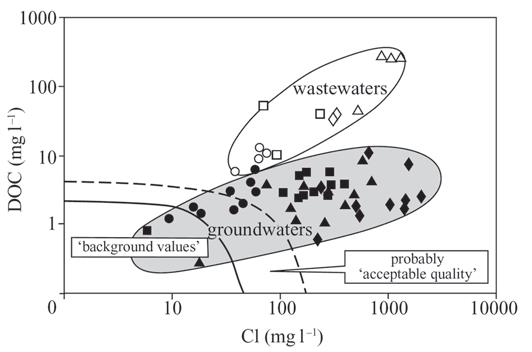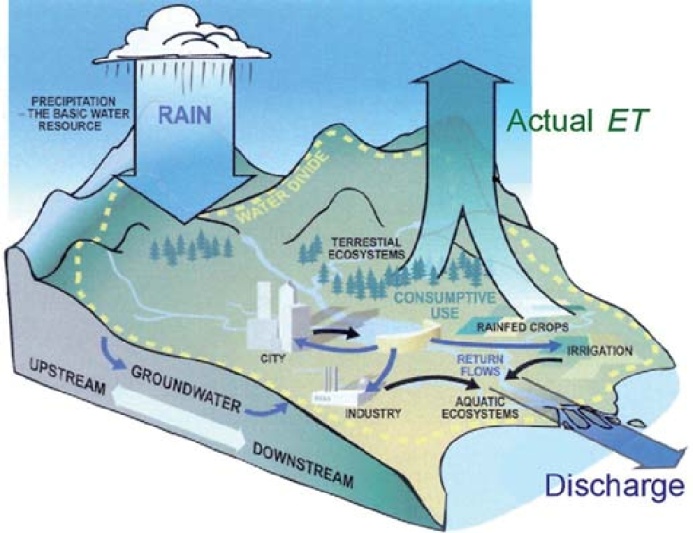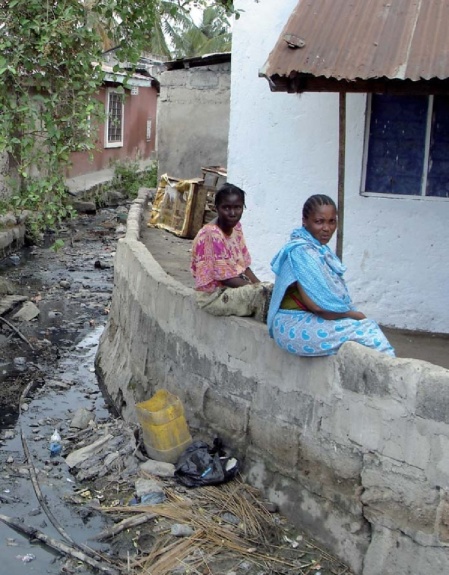Sustainable Sanitation & Groundwater Protection
Contents
- 1 1. Summary
- 2 2. Why care about groundwater
- 3 3. Introduction to groundwater pollution
- 4 4. Pathogenic pollution
- 5 5. Chemical pollution
- 6 6. Pollution due to organic micro pollutants
- 7 7. Protecting groundwater from pollution
- 8 8. Productive land use and groundwater protection
- 9 9. Policy recommendations
- 10 10. Acknowledgements
1. Summary
Groundwater quality and sanitation are often linked as pollution of groundwater from unsafe household sanitation systems through nutrients, pathogens and organic micropollutants (including emerging contaminants) can occur.
There are many tools to prevent groundwater pollution: land-use planning plays an important role in protecting areas that are vulnerable by restricting the use of these areas. Water Safety Plans can play a fundamental role for communities to protect groundwater quality. In larger frameworks such as transboundary aquifers, Integrated Water Resources Management (IWRM) schemes are required to protect recharge areas, even if they are distant from the points of abstraction.
Sanitation solutions need to be adapted to the regional conditions in order to be sustainable. Accessible and safe sanitation and good groundwater quality are critical elements for sustained growth in developing countries that require policy and legal support systems to remain effective. This includes developing educational curricula (focussing on groundwater and sanitation) as well as institutional capacity building programmes.
Failure to improve general sanitation conditions and thereby contaminating groundwater endangers the economic growth potential of a region. This may impact negatively on the overall economic output due to increasing costs in the health, labour and production sectors. Sanitation and groundwater issues including capacity development need to be addressed on all political levels of government.
2. Why care about groundwater
In arid and semi-arid countries groundwater is very often the sole resource for agricultural irrigation. All these facts turn groundwater in most areas of the world into an affordable, reliable and an inevitable key element of sustainable human development.
3. Introduction to groundwater pollution
Historically it was widely believed that groundwater is generally pure and safe for drinking purposes even without treatment. However, in the past few decades, cases of disease outbreaks due to the consumption of untreated, contaminated groundwater have increasingly been reported.
Groundwater contamination occurs when substances are introduced into the aquifer environment due to human activities such as urbanisation, industrial and agricultural development. All of these activities use water and produce wastewater, which may potentially pollute groundwater resources. When the contaminant concentration reaches a certain level the potential uses of groundwater are restricted and the groundwater is said to be polluted.
There are two types of sources of groundwater contamination which can be classified according to their origin. Single-source contamination can be localised and can easily be identified; whereas contamination from multiple sources or non-point sources is wide in scope and is more difficult to control. The major sources of groundwater contamination are poorly-designed septic tank systems, poorly constructed pit latrines, leaking sewers, unsanitary dumpsites, unlined chemical landfills, intensive agriculture and wastewater disposal ponds. Other causes include spills and leaks; mine drainage; poorly constructed or abandoned water, oil and gas wells; and road de-icing salts.
In some instances, contaminated groundwater is localised; however, in many cases a single source contamination may spread a considerable distance from the source, depending on the type of contaminant and the hydrogeological conditions.
The main task of a sanitation system is to contain and sanitise human excreta which contain pathogens in order to prevent the spread of diseases. A sanitation system consists of more than toilets and pits dug in the ground to collect excreta and effluents. It comprises the whole chain of household facilities, collection, transport, treatment and final destination (either disposal or reuse). Each of these components has the potential to cause pollution to the groundwater. In dealing with pollution generated by sanitation systems, the following pollutants are of importance: pathogens, chemicals and organic micropollutants.
4. Pathogenic pollution
Pathogens cause diseases such as cholera, hepatitis A and diarrhoea. In those countries where groundwater is the sole source of drinking water, prevention of faecal-oral transmission should be a highly prioritised public health outcome. Once pathogens have infiltrated into the groundwater it takes different amounts of time for different types of pathogens to die off. During this time, groundwater travels a certain distance depending on the permeability of the aquifer (i.e. the groundwater body). In addition to natural die-off, pathogen removal is also a result of adsorption and filtration through the soil and sub-surface media.
Moreover, since the die-off of microorganisms tends to occur logarithmically over time, the complete removal of microorganisms does not only depend on the die-off rate, but also on the initial concentration. For example, when die-off dictates that in 50 days 100 microorganisms die per litre, a concentration of 1000 microorganisms per litre will only be reduced to 10 organisms per litre after 50 days, and therefore, in such case, removal is incomplete.
It must be noted that it requires professional experience and knowledge of the subsurface conditions to estimate the minimum distance in the soil aquifer system, which results in a travel time of 50 days. If there is doubt, always use a conservative estimate and account for larger distances.
5. Chemical pollution
The more and more anaerobic (i.e. lacking oxygen) the groundwater environment becomes the more microorganisms are forced to utilise other substances, other than oxygen, for degradation of organic matter and thereby release their metabolism products into the groundwater. This results in a fundamental change in the groundwater chemistry, including increases of dissolved ammonia, manganese, iron, hydrogen sulfide, methane and possibly also metalloid substances such as arsenic.
a) Pollution due to nitrogen compounds
The nitrogen (N) cycle is complex; the predominant wastewater and animal manure related nitrogen form entering the (un)saturated zone from untreated sewage is ammonium while from treated sewage and from chemical fertilisers it is nitrate. The main mechanism for the transformation of N from wastewater that has infiltrated in the soil is denitrification, whereby first ammonium (NH4+) from wastewater is oxidised into nitrate (NO3-, called nitrification). Then, further in the aquifer, provided that anaerobic conditions prevail, nitrate is reduced into nitrogen gas (N2, called denitrification), which is stable and ultimately may escape to the atmosphere.
When aerobic conditions prevail, nitrate may be the final product, which, at elevated concentrations (>50 mg/l), can be harmful to humans, especially babies. Worldwide, in developed and developing countries alike, many water supply wells show increased levels of nitrate above the WHO guideline value of 50 mg/l. This can be due to fertiliser application or mismanagement of human and animal excreta, but also due to natural conditions.
b) Pollution due to phosphorus
The main source of phosphorus in wastewater is inorganic orthophosphate and organic phosphorus. Due to anaerobic digestion, the latter is usually transformed into orthophosphate. Phosphorus transport in groundwater exists, however health threats occur only indirectly. Phosphate in aquifers is usually bound to iron-oxides (Dzombak, Morel, 1990) or precipitates as phosphate minerals, like hydroxy-apatite, vivianite, variscite or strengite.
Such soils have been linked to accelerated eutrophication of freshwater bodies: Phosphate is a limiting factor in algae growth in surface aquatic ecosystems. This means, if there is not enough phosphate, algae growth is reduced, while the more phosphate there is, the more algae growth can take place. Excessive algae growth can lead to the depletion of oxygen from decaying algae, the reduction of fish populations or the predominance of single fish species, and the production of toxins (microcystins) from certain algae species which can impact on human and animal health.
c) Pollution due to other anthropogenic induced pollutants
In some settings, due to the infiltration of wastewater, toxic compounds like arsenic are released. Of the various routes of exposure to arsenic, drinking water probably poses the greatest threat to human health. The International Agency for Research on Cancer (IARC) has classified arsenic as a Group 1 human carcinogen.
Serious and long lasting groundwater contamination is known to result from chemical substances like chlorinated, hydrocarbons, BTEX, polycyclic aromated hydrocarbons (PAH), which are often introduced via leakages or spillage events. Where such industry chemicals are discharged into the wastewater, the drainage system is providing an additional entrance pathway to groundwater.
6. Pollution due to organic micro pollutants
Organic micropollutants or so called “emerging contaminants” are now frequently being detected in wastewater and the environment in concentrations up to several μg/L, although they might have been present already for decades (Ternes, 2009). Prominent examples of emerging contaminants are pharmaceuticals, estrogens, ingredients of personal care products, biocides, flame retardants, benzothiazoles, benzotriazoles or perfluorinated compounds (PFC). Organic micropollutants are usually quite small (molecular weight predominantly varies between 50 and 1000 Da), therefore regular municipal WWTPs or on-site sanitation systems do not remove these polar persistent organic pollutants.
Pollution of groundwater and drinking water by emerging contaminants is well documented; however human health risks are low in most cases. Many of these contaminants are continuously discharged to the environment, therefore the most important question “Which are the most hazardous or unwanted emerging contaminants?” arises. Definitive answers cannot be given yet. Criteria for answering this question might be related to the ecotoxicological (in aquatic or terrestric environment) and toxicological relevance, the potential to bioaccumulate, as well as the potential to contaminate groundwater and drinking water.
Adverse effects by individual emerging contaminants, like “feminisation” of fish, can occur down to a few ng/L, as reported for 17α-ethinylestradiol and tributyltin. Besides endocrine disrupters, pharmaceuticals (such as carbamazepine, diclofenac, fluoxetine, propranolol) have been shown to cause effects at environmentally relevant concentrations. Current research is providing a growing list of “predicted no-effect-concentrations” (PNEC) which constitute the lowest concentration where a specific emerging pollutant was observed to have an effect on any organism.
7. Protecting groundwater from pollution
a) Source protection
The best way to protect groundwater is to prevent contaminants from entering the aquifer which pose a threat to water quality and are hazardous to human health. One practical way to achieve this is land-use planning. In order to prevent groundwater contamination, drinking water protection areas are delineated around production wells or springs (see Figure 3).
b) Resource protection
An empirical model to map aquifer vulnerability has been developed by the USA National Water Well Association and the Environment Protection Agency. The DRASTIC approach refers to hydrogeological units incorporating major factors which affect and control groundwater movement (Depth to groundwater table, net Recharge, Aquifer media, Soil media, Topography, vadose zone media Impact and hydraulic Conductivity of the aquifer). These factors form the acronym DRASTIC and give their rated and weighted input to the numerical DRASTIC index (USEPA, 1987). This index, in combination with the mappable hydrogeological settings, creates a groundwater vulnerability map. The approach helps to prioritise monitoring and protection measures.
c) How to protect the groundwater resource
An integrated water resources management (IWRM) approach is needed in the urban context as it explicitly recognises the complex sets of interdependent relationships which exist within and between human and environmental systems. One guideline of an IWRM approach is that water decisions should be made at the lowest appropriate scale.
Rees (2006) elaborates that for every setting the different roles which water management organisations might play and the different functions which agencies might perform along water supply chains must be defined. The IWRM approach, when applied in an urban context, recognises intersectoral competition for resources (physical, social and financial). This involves the creation of an institutional framework; within which water relevant roles and functions are performed at an appropriate spatial scale, and which helps to ensure that decision makers have incentives to take the social costs of their actions into account.
From the groundwater resource protection point of view, the catchment needs to provide a recharge area which is part of the ecosystem mosaic and free of human activities. Ideally, the area in which humans consume water for domestic and industrial use should be situated downstream of the recharge area while agricultural activities may lie even further downstream, allowing for use of nutrients from domestic water and sanitation.
8. Productive land use and groundwater protection
Most synthetic fertilisers consist of a combination of phosphorus (P), nitrogen (N) and potassium (K). While phosphorus and potassium are prone to sorption processes in the soil, nitrogen reaches the groundwater at the same time as the percolating water. Therefore, in order to prevent high nitrate concentrations in groundwater over the longer term and eutrophication of surface waters, regulations on fertiliser application should be developed and enforced. Organic fertiliser, which produces less leakage of nitrate into the groundwater (UBA, 2002) is preferred over synthetic fertiliser, and soil should be managed in a sustainable way. Erosion, leakages of nutrients and loss of humus should be avoided.
9. Policy recommendations
The following recommendations were developed by the participants of the international symposium “Coupling groundwater protection and sustainable sanitation” which took place in Hannover, Germany in 2008 (BGR, 2008).
- Both, groundwater protection and sustainable sanitation represent basic tasks for all development planning. Every new settlement should take groundwater resources into account and the protection of aquifers should have a high priority. Land-use planning, based on a holistic approach and therefore economically, socially and ecologically sound, is required to protect precious resources like groundwater.
- To fulfil the five sustainability criteria, a sanitation system has to be not only economically viable, socially acceptable, and technically and institutionally appropriate, it should also protect the environment and the natural resources. Geoscientific aspects have to be considered during sanitation planning, including climate, hydrogeology, soil characteristics and geo-morphology.
- Uncontrolled and unregulated utilisation of must be prohibited. Guidelines for the safe reuse of excreta and wastewater WHO (2006) need to be incorporated in practise and imbedded in all implementations.
- Additionally, the reuse of wastewater, human excreta and greywater in agriculture requires further studies and implementation policies in developing and developed countries.
- Efficient political structures, policies and legal arrangements are essential. This includes developing curricula (focussing on groundwater and sanitation) for educational systems as well as capacity building programmes. Neglecting the improvement of general sanitation conditions and thereby contaminating groundwater endangers economic output due to increasing costs in the health, labour and production sector. Sanitation and groundwater issues including capacity development have to be addressed on all political levels.
10. Acknowledgements
SuSanA factsheet: Sustainable sanitation and groundwater protection. April 2012. susana.org






